1. Background
The tarnished plant bug (TPB), Lygus lineolaris (Fig. 1), is a major concern in strawberry production areas across Ontario and until now, intensive use of insecticides has been the only means of control. Tarnished plant bug adults and nymphs feed on all parts of the plant by sucking sap, destroying embryos within seeds and preventing fruit tissue growth beneath the seed. The resulting misshapen berries are known as "cat-faced" and are unmarketable (Fig. 2). In Ontario Lygus goes through two full generations and a partial third generation per year in southern Ontario and has adverse impacts on strawberry production throughout the growing season: first generation nymphs cause severe economic damage to June bearing cultivars, while second-generation nymphs are the major limiting factor on later dayneutral cultivars.
Figure 1. Adult Tarnished Plant Bug
Agriculture and Agri-Foor Canada (AAFC)
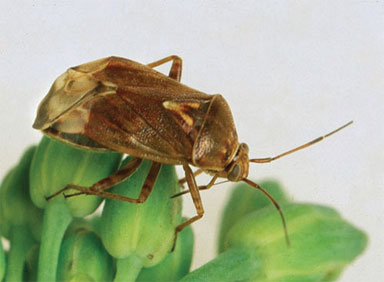
The high risk of Lygus populations developing resistance to insecticides, concerns about the impact of insecticides on beneficial insects, pollinators and human health, and increasing competition with imported berries from the United States, Mexico, China and eastern Europe have driven a search for new control strategies for these plant bugs based on no, or only limited use of, conventional pesticides.
Figure 2. TPB feeding damage: "Cat-faced" strawberries.
T. Haye, Centre for Agricultural Bioscience (CABI)
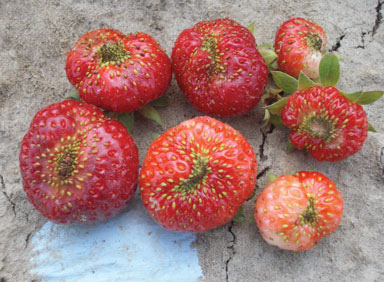
2. Integrated Pest Management Concept for Tarnished Plant Bug Control in Strawberries
Agriculture and Agri-Food Canada (AAFC) and Health Canada's Pest Management Regulatory Agency (PMRA) established the Pesticide Risk Reduction Program together with industry and the Canadian provinces in 2003 with the aim of reducing the risks to the environment and consumers from pesticides used in agriculture. As part of this program an Integrated Pest Management (IPM) strategy for Lygus in Ontario strawberries has been developed by CABI Europe-Switzerland in 2006 in collaboration with Canadian partners in Ontario Ministry of Agriculture, Food and Rural Affairs (OMAFRA), AAFC and the University of Guelph. The IPM strategy combines trap cropping, classical biological control and a reduced risk approach using chemical control:
- Trap crops such as alfalfa planted along the edges of, or within, strawberry fields have the potential to limit plant bug damage by offering the pest a food source they prefer to the strawberry crop itself: Lygus adults migrating from adjacent areas are concentrated in the trap crop and numbers of adults migrating into strawberry are reduced. Alfalfa had earlier been identified as the most effective trap crop for Lygus bugs in California.
- At conventional strawberry farms insecticides are applied to the trap crop after adult migration, reducing the number of Lygus females before they start laying eggs. This way the number of developing nymphs, which cause the main damage, is reduced and the need for insecticide applications in the strawberry crop itself is avoided. On organic farms, where insecticide use is prohibited, the alfalfa strips need to be partially cut and removed as soon as the Lygus adults have laid most of their eggs.
- When small Lygus nymphs are present, a classical biological control agent, the European nymphal parasitoid Peristenus digoneutis Fig. 3), is released to further reduce the Lygus populations in the strawberry growing area.
Figure 3. Peristenus digoneutis attacking plant bug nymph.
T. Haye, CABI
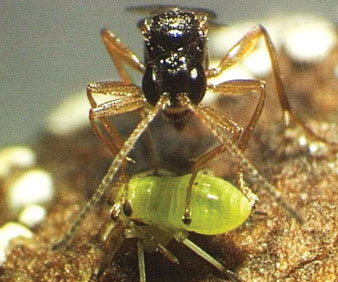
3. Capacity Building
To exchange background information about organization and management of Ontario strawberry farms, TPB pest biology and alternative control options farmer participatory workshops (FPW) were held in 2006 at central locations in southwestern and eastern Ontario. At each FPW an overview presentation was made to describe the life cycle of TPB, its movement into the strawberry crop, and how the parasitoids interact with TPB and the surrounding habitats. In following discussions, farmers were selected for the study. Since there are also several organic strawberry growers in Ontario, it was determined that these growers would be the most open to new methods for managing their pest problems, and thus they were included into the study.
By presenting to the growers information on the biology of TPB and how the parasitoid Peristenus digoneutis contributes to pest mortality, capacity was built to help growers make decisions about how their crop might be best managed using biological control. Growers became knowledgeable about the problem and how a biologically based solution could help. Discussion of constraints for individual growers allowed to better design a unique management strategy for each operation. For example, the location, type and size of a trap/refuge crop depended on the land available.
After each field season, a 'farmer participant report template' was developed to provide growers with an individualized summary of results on their farm and points for follow up at on-site discussions before the next growing season. At the end of the project a questionnaire was developed to assess the growers' responses to the IPM program.
Figure 4. On-farm parasitoid releases.
K. Makela, AAFC
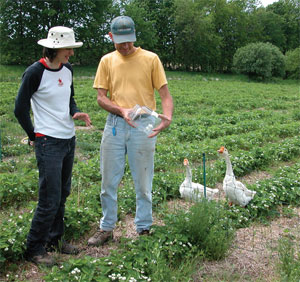
4. Integrated Pest Management Implementation in Ontario
The field implementation of the IPM strategy in Ontario was started in 2007 and has continued in 2008. Together with participating farmers, augmentative field releases of European biological control agent Peristenus digoneutis were conducted at two sites in southwestern Ontario [Simcoe region] and one site in eastern Ontario [Kingston region] in 2007 and 2008 (Fig. 4). In total, 8,880 mated females were released directly into trap crops adjacent to strawberry fields. Monitoring for Lygus and parasitism was then conducted throughout the field season in the crop, trap crop, and surrounding weedy areas (Fig. 5). At the same time, damage in the strawberry crop was monitored to assess the impact of the IPM strategy.
Figure 5. TPB sampling in trap crop.
A. Brauner, AAFC

5. Results of Integrated Pest Management Implementation
In Eastern Ontario, neither pesticide applications nor inoculative releases of the biocontrol agent Peristenus digoneutis in 2007 prevented TPB population to increase at all sites in 2008 (Fig. 6). This increase was likely caused by a lower overwintering mortality of TPB adults in winter 2007/8. Remarkably, in 2008 the parasitoid was also recorded at sites where it was never released before, indicating that it is widely established throughout Eastern Ontario. Data from 2008 show clearly that with increasing TPB densities, parasitism by Peristenus digoneutis increases as well (Fig. 6). This agrees with former observations in the United States (U.S.), showing that the parasitoid reacts positively to increasing TPB densities. An area-wide increase of TPB parasitism has not yet resulted in significant reduction of TPB populations in Eastern Ontario, but it is expected in the longer term. In Southern Ontario, no uniform development of TPB populations was observed in 2008 (Fig. 7). As in Eastern Ontario, parasitism levels followed TPB densities. At the organic strawberry site, where TPB densities dropped in 2008, parasitism declined as well. The opposite trend was observed at the conventional strawberry site, where parasitism increased with TPB densities. TPB damage difference between 2007 and 2008 at conventional strawberry farms both increases and decreased on the site, likely due to different management techniques from previous years (Fig. 8). In contrast, berry damage remained constant between years at both the organic farms participating in the IPM program. Overall, three growers did not apply any pesticides and another farm substantially reduced pesticide input in 2008 compared with previous years.
Figure 6. The total number of N4/N5 nymphs over the collecting season and the percent parasitism at peak N4/N5 dates in strawberry fields at Eastern Ontario Farms in 2007 and 2008. * indicates significant difference in N4/N5 numbers between years; N4/N5 numbers followed by the same letter are not significantly different (Tukey Test, P < 0.05).

Description - Figure 6
The image shows two bar graphs, representing 2007 and 2008. The graphs each show the number of N4/N5 Nymphs on a scale from 0-200 and the Level of Parasitism from 0% to 100%. Three sites are plotted for each graph: Organic (release site), Conventional site 1, and Conventional site 2. Each graph contains two variables: Total N4/N5 nymphs and % Parasitism at peak of N4/N5. For 2007 the peak parasitism levels averaged about 20% at the organic farm, 0% at conventional site 1 and less than 5% at conventional site 2. The total number of nymphs at each farm was about 50 at the organic site, less than 10 at conventional site 1 and about 50 at conventional site 2. For 2008 parasitism levels in strawberry crops were higher at all farms, more than 60% at the organic site, about 20% at conventional site 1 and about 5% at conventional site #2. Total number of nymphs was about 170 at the organic site, about 100 at conventional site 1 and about 40 at conventional site 2. Parasitism levels were higher when N4/N5 NYMPHS numbers increased. In both years parasitism levels were significantly higher at the organic farm than at either of the conventional farms.
Figure 7. The total number of N4/N5 nymphs over the collecting season and the percent parasitism at peak N4/N5 dates in strawberry fields at Southern Ontario Farms in 2007 and 2008. * indicates significant difference in N4/N5 numbers between years; N4/N5 numbers followed by the same letter are not significantly different (Tukey Test, P < 0.05).
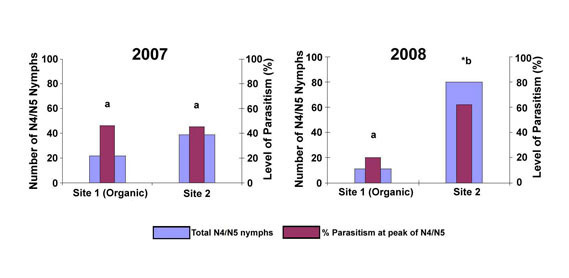
Description - Figure 7
The image shows two bar graphs, representing 2007 and 2008. The graphs each show the number of N4/N5 Nymphs on a scale from 0-100 and the Level of Parasitism from 0% to 100%. Two sites are plotted for each graph: site 1 (organic), and site 2. Each graph contains two variables: Total N4/N5 nymphs and % Parasitism at peak of N4/N5. For 2007 the peak parasitism levels averaged, more than 40% at the organic site and about 40% at the conventional site. N4/N5 NYMPHS numbers were about 20 at the organic site and about 40 at the conventional site. For 2008 the parasitism level at the organic site was lower averaging 20% and higher at the conventional site at 60%. This corresponded to a lower number of TPB nymphs at the organic site (about 10) and an increase in N4/N5 NYMPHS nymphs at the conventional site (about 80).
Figure 8. The change in TPB berry damage from 2007 to 2008 in Eastern Ontario Farms (3 collections/site/year). * indicates significant difference in overall TPB berry damage between years; overall TPB berry damage followed by the same letter are not significantly different (Tukey Test, P < 0.05).

Description - Figure 8
The image shows one bar graph representing the % change between 2007 and 2008 in berry damage caused by the N4/N5 NYMPHS. The graph shows the % change in berry damage on the left axis on a scale from −5 to 40%. Three sites are plotted for each graph: Organic (release site), Conventional site 1, and Conventional site 2. Each site has three bars, each representing a different collection date for each site. At conventional site #1 berry damage was significantly higher in 2008 than 2007 (+35%, +30% and +12%). There was no significant difference in berry damage between years at the organic farm (−1%, +9%, approximately 0%) and conventional site #2 (−4%, +1%, −2%).
6. Conclusions and Future Perspectives
The current distribution of P. digoneutis in Canada shows that the parasitoid is now well established in eastern Ontario in parts of southern Ontario. In the northeastern United States, it took almost ten years before a significant impact of P. digoneutis was recognized and Lygus populations collapsed. Thus, it is hoped that a continuous growth of P. digoneutis populations Ontario will have a similar long-term effect and lead to an area wide reduction of the pest. This also suggests that ongoing work to encourage population build up and assess impact is needed. In addition, surveys in other parts of Ontario would help to identify areas where the parasitoid is not yet present, and releases would help to accelerate the dispersion and establishment of P. digoneutis.
About the Pesticide Risk Reduction at Agriculture and Agri-Food Canada
The Pesticide Risk Reduction team delivers viable solutions for Canadian growers to reduce pesticide risks in the agricultural and agri-food industry. The team achieves this goal by funding integrated pest management projects and coordinating pesticide risk reduction strategies developed through consultation with stakeholders and pest management experts. Other sustainable crop protection factsheets are available. For more information please visit the Pest Management Centre.